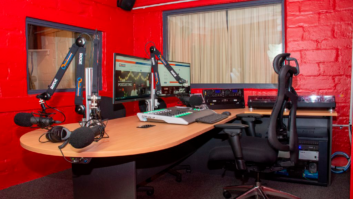ORLANDO, Fla. — Most radio stations in highly competitive markets take a serious interest in their on-air sound. At WHKQ(FM), better known as KQ103, we’re no exception. In fact, we’ve probably been more obsessive about it than most in the last few months!
Our station recently went through a format change, and our new Spanish CHR format was going to require significant changes to our on-air processing. We were rebuilding our studios entirely, and since we’d never been satisfied with our previous processors, we decided it was time for a change.

Multiple choice
We accepted many offers to evaluate several manufacturers’ processors with varying results. Our experience with the flagship processor of one manufacturer was not promising at all. The unit had to be sent back for repair once during the demo period, and much of its functionality came in the form of promised “future free upgrades.” We passed.
In August, Wheatstone allowed us to evaluate their flagship processor, the AirAura. When we received it (a brand-new unit, not a prototype), we installed it right away. We were surprised to find that we could set up a very acceptable sound using the provided presets. We saw improvement over our old processing right out of the box. A few days later, Wheatstone’s Mike Erickson came down and helped us make some additional adjustments. Mike really made it sing and we’d never heard anything like it.
The demo taught us that the AirAura was far better than the rest of the units we’d tried, both in terms of its ability to improve our on-air sound and in the ease of manipulating its settings and parameters.
By far the most important person to satisfy was our general manager. His “golden ears” determine what flies and what doesn’t for KQ103.
The AirAura was the first processor we evaluated that gave him what he truly wanted to hear on our station. The decision was made in December of 2011 to purchase it, and Wheatstone scheduled another visit from Mike Erickson for the final tweaks.
For that adventure, we gathered together eight vehicles, including the GM’s car, my truck, and even Erickson’s rental car, and headed to the roof of the parking garage for the strongest possible signal. Communicating between cars using smartphones and iPads, and using a laptop to adjust the AirAura remotely, we were able to discuss, implement and test various processing changes until we’d arrived at a loud, clean, competitive sound that satisfied everyone.
After several months with the AirAura, we’re confident we’ve found the processor that will give our station the best sound possible. The boss even feels that the AirAura has improved some of the atmospheric and multipath issues he has experienced living on the back side of our antenna pattern.
Not only did we notice the difference, but apparently our competition noticed, too. In the weeks that followed, we took note of perceptible increases in loudness on several other stations in our listening area. We can’t conclusively connect the two, of course; but what we do know is that in spite of their changes, KQ103 remains among the loudest signals — and the best sounding — on our dial. And in a competitive Florida market, that’s an accomplishment.
Bill Sullivan is chief engineer with WHKQ(FM).
For information, contact Jay Tyler at Wheatstone in North Carolina at (252) 638-7000 or visit www.wheatstone-processing.com.












